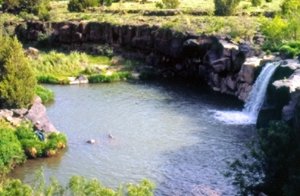When the Denver, Texas and Ft.
Worth Railroad was finished in 1888, the construction camp of Ragtown became Folsom
in honor of Frances Folsom, who married President Cleveland in the White House.
The village thrived and had many businesses and residents until 1908, when a disastrous
flood washed away most of the town. Sarah Rooke, the telephone operator, stayed
at her switchboard warning people of the coming flood until her building was swept
away. She was honored as a heroine. Seventeen people lost their lives and most
of the businesses were never rebuilt.
Folsom Man Left His Mark
In the early 1900’s, George McJunkin, black foreman for the Crowfoot Ranch,
discovered large bones in a dry arroyo. No one was interested until 1926, when
scientists excavated and found 23 or more ancient Bison skeletons and 19 projectile
points. Though George McJunkin didn’t live to see the importance of his discovery,
it opened a new horizon in North America’s past. Later discoveries in other
places confirmed the theory that man had occupied the New World longer than anthropologists
supposed – at least 10,000 years. The points were unique, as they were worked
twice on the edges and grooved down the center on each side. The point was named
Folsom Point after the nearby town of Folsom. So far, no human bones of the Folsom
Man have been found, but the point proves they were here many years ago.
Folsom Museum
The Folsom Museum, organized in April 1966 to preserve history and artifacts of
the area, is housed in the historic Doherty Building, built in 1896 on the mail
street of Folsom. |
 |
|

